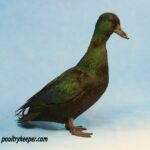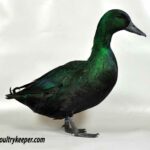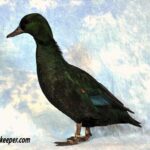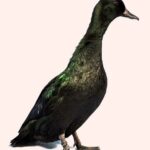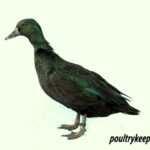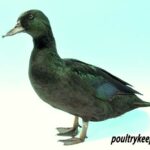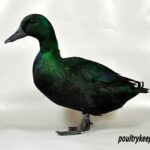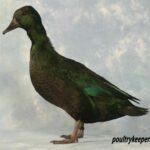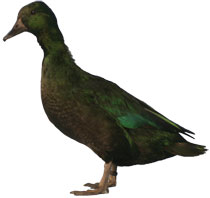 Uses: Exhibition, ornamental.
Uses: Exhibition, ornamental.
Eggs: 40 to 100 White Eggs.
Origin: U.S.
Weight: Drake: 900g, Duck: 700 – 800g.
Classification: Bantam.
Useful to Know: Drakes will remain black, but females will get white patches as they age. Being a bantam breed, they are light enough to be good fliers.
Photo: A Black East Indian Duck.
The Black East Indian duck is the oldest breed of bantam duck. Despite its exotic sounding name, it is thought to have originated from America during the 19th century, the name possibly only being used to help sell it. Exotic and foreign poultry breeds were popular and could command a better price.
Black East Indian ducks are amazing to look at, having jet black bills and a beetle green iridescent sheen to their plumage that can only be seen at certain angles as the light reflects off it. This colour gene is shared with the Cayuga, which is also from America.
Female ducks have extended black genes and as a result will get white patches on them after their first year of life. This is normal and no amount of breed selection will remove this. Read White Patches on Ducks With Extended Black Genes for further information.
Black East Indies have unusual dark grey, even black coloured eggs. These will fade in colour to a light grey, even blue towards the end of an egg laying cycle.
The Black East Indian entered the British standards in 1865. In America this duck entered the American Standard of Perfection in 1874 and goes by a different name: The East Indies but is often called the Black East Indies in America.
Photos
Books
The following books are available. Links take you to the Amazon or other sellers’ pages for the books.
- British Waterfowl Standards 2008 – P.119
- British Poultry Standards 2008 – P.389
- American Standard of Perfection 2010 – P.344
Discussion
- Looking for stock? Visit the Waterfowl Section of our Forum
- Please leave a comment below if you can provide further information or have a question about this breed.

